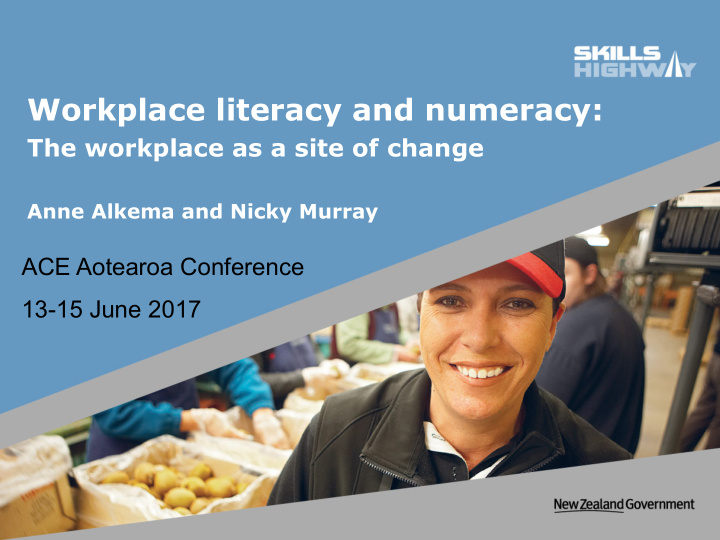



Workplace literacy and numeracy: The workplace as a site of change Anne Alkema and Nicky Murray ACE Aotearoa Conference 13-15 June 2017
Skills Highway • The Skills Highway team • Research and evalua8on • Promo8on and resource development e.g.: o Website and newsle@ers o Health and safety Pathways Awarua modules and collateral o Employer and learner-friendly ‘front pages’ for the Learning Progressions o Workshops for providers and ITOs
Survey of Adult Skills: NZ high level results
What is PIAAC? PIAAC measures adults’ skills in: § Literacy § Numeracy § Problem-solving in technology-rich environments PIAAC gathers background data on education, employment, skills and qualifications required for work and used at home PIAAC enables us to explore relationships between skills, education and employment, controlling for linguistic and socio-demographic factors
The big picture § Score above OECD average in literacy, numeracy and problem solving in technology-rich environments § Differences in skills proficiency related to age, gender, education and social background are less pronounced in NZ than in other countries but sharp ethnic differences exist, particularly for M ā ori and Pacific peoples § NZ-born adults who speak English as a 2 nd language are over-represented among adults with low proficiency § In NZ, higher proficiency in literacy and numeracy has a positive impact on labour force participation and wages § There is a relationship between literacy levels and levels of trust in others, political efficacy, participation in volunteer activities and self-reported health
How NZ stacks up against other countries
Skills and ethnicity
Skills and ethnicity over 8me
Skills and place of birth
Who gets training at work § NZ ranks higher than OECD average for participation in formal and informal training § People working in low-skilled occupations spend fewer hours in formal training than those in high skilled and are more likely to have no learning activities § In New Zealand, the industries with the lowest participation rates in on-the-job learning in the 12 months before the survey: • accommodation and food service activities (35%) • administrative and support service activities (32%) • agriculture, forestry and fishing (30%).
Produc8vity and use of reading skills Unadjusted Adjusted Linear (Unadjusted) Linear (Adjusted) 4.8 Slope:0.774 Slope: 0.666 (0.174) (0.231) 4.6 R-squared: 0.321 R-squared: 0.261 (log) labour productivity NOR 4.4 NOR USA 4.2 IRE FRA BEL USA IRE DNK NDL FRA DEU DEU BEL ITA SWE DNK 4 AUT ESP AUT NDL FIN AUS AUS ITA ESP SWE GBR CAN GBR 3.8 CAN FIN TUR SLO ISR CHL JPN GRC SLO NZL ISR 3.6 NZL GRC SVK JPN CZE LIT LIT SVK CZE TUR KOR 3.4 KOR EST POL POL EST RUS¹ CHL RUS¹ 3.2 3 1.7 1.9 2.1 2.3 2.5 2.7 2.9 3.1 3.3 Mean use of reading skills at work
Discussion § What interests or surprises you about these results? What are the implications of these findings for your § communities and the programmes you run? What are the implications for regional labour markets § and workplaces? How might you support workers in your § communities to improve their literacy and numeracy skills?
Literacy and numeracy funds – a flyby! Workplace Literacy and Numeracy Fund: – Training provider programmes (TEO-led) – Employer-led funding Other funds: – Intensive Literacy and Numeracy (ILN) – Intensive Literacy and Numeracy – English for Speakers of Other Languages (ILN – ESOL) – Refugee English Fund – English for Migrants – Adult and Community Education (ACE) fund
What’s different about workplace literacy and numeracy? • Working closely with the employer to identify: o What are the issues in the workplace that result from low levels of literacy and numeracy? o How will the intervention/programme address these issues? o How will the employer know that the intervention has made a difference?
What does an Employer-led WPLN programme look like? Key points: • Minimum of 20 employees (or a consortium) • Programme between 25 to 80 hours; intensity of between 1 to 4 hours per week • Employee eligibility • Standalone LN programme, contexualised to the workplace, with appropriately qualified tutors • Employer contribution • Clear measurements of change • Sustainability
What do we look for? High quality is marked by: • – a clear articulation of the employer’s productivity opportunities or problems that literacy and numeracy training can address – understanding and measurement of employee practices that need to change to improve – measurement of employees’ literacy and numeracy using the Assessment Tool pre- and post-training intervention – understanding and reporting of personal outcomes for employees that then contribute to a higher performing workplace
Workplace literacy and numeracy in action! • Carter Holt Harvey Woodproducts Ltd https://www.youtube.com/watch?v=bS33HrAgEFM&t=60s • Pacific Homecare https://www.youtube.com/watch?v=6PBrirkSHxQ
And now it’s your turn! How can adult and community provision: o connect with o extend o and sustain the benefits of workplace literacy and numeracy provision?
Connection How do we better connect adult and community provision • with workplace literacy and numeracy? How do we support better connection with ‘near work’ and • ‘at work’ learners? How can we better connect with workplaces in your • communities where there may be good opportunities for workplace literacy and numeracy programmes? Barriers and enablers? •
Extension • How might adult and community provision extend the applicability and range of workplace literacy and numeracy programme components, e.g.? o Digital capability o Financial capability o ESOL • Barriers and enablers?
Sustaining the benefits • How can adult and community provision support the sustainability of the benefits accrued from workplace literacy and numeracy programmes, e.g? o Support for and promotion of lifelong learning o Connection with REAPs o Connection with local libraries • Barriers and enablers?
Keep an eye on the website for future developments!
Recommend
More recommend